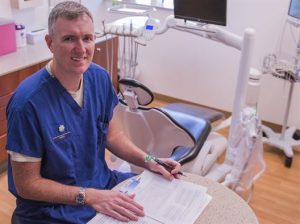
What’s the difference between a dentist and orthodontist? No, that isn’t a corny joke leftover from a budget Christmas cracker. It’s an extremely important question that many people ask when they first approach a dental health expert for treatment.
Dentists and orthodontists are both trained medical professionals dedicated to helping patients improve their oral health issues. Dentistry, however, is a broader medical specialty that takes in a whole range of treatments and issues, from dealing with fillings, extractions, gum disease and abscesses to cosmetic dentistry procedures such as teeth whitening, crowns, implants and veneers. Dentists also become involved in advising on good oral hygiene and encouraging best practice around brushing and cleaning teeth, healthy eating and gum, tongue and throat care.
A qualified orthodontist is also a dentist, however, not all dentists can call themselves orthodontists. This is due to the additional, specialist training involved in a specialist orthodontic study, which can take up to two or three years extra to complete on top of the eight or so years of study required to qualify as a dentist. This is a similar picture to the related medical science of surgery – not all doctors are qualified surgeons, but all surgeons will have had to undergo recognised medical training in order to become a doctor.
Both orthodontists and general dentists must register with the relevant professional bodies to ensure that treatment standards, patient care and an ethical approach to their work remain at the very top of their priorities. Many dental patients can feel anxious about starting treatment, so this registration process is also designed to add confidence at a difficult time. A list of registered dentists and orthodontists is available on the General Dental Council’s website.
Introducing Orthodontics
Orthodontics service focusses on a narrower specialty of dentistry covering the development of the face, teeth and jaws and improving medical and aesthetical issues via non-surgical corrective procedures.
Issues that require an orthodontist’s help might include straightening crooked teeth, realigning crowded teeth, closing unsightly gaps in the mouth, correcting overbites and underbites and treating occlusion (contact between teeth that causes pain and adversely affects the chewing of food). Orthodontists can also become involved in treating serious problems with the jaw, facial bones and other related issues around the head or neck.
Often, orthodontic treatment takes the form of fixed braces or removable retainers, such as braces or aligners, that gently move teeth into their described position by applying constant pressure on the affected areas. Even after orthodontists graduate from this lengthy and arduous period of medical training, they must remain constantly updated and informed about developing techniques and ways of thinking within their chosen field of medicine. After all, an orthodontist will need to treat patients with a wildly varying set of issues, from a very mild aesthetic concern, right up to highly complex medical issues requiring a more sophisticated approach, or even surgery in more extreme cases.
Dentists and Orthodontists working together?
So, can a dentist also provide orthodontic treatment? Yes, they can be provided they have received the correct training, passed the required exams and are qualified to carry out the work. Finding a dentist who also practices orthodontics is not always commonplace, due to the heavy workload that most dentists already experience with their existing patient care and the fact that an orthodontist will normally have greater knowledge and teeth realignment options at their disposal. Rather, dentists tend to work in partnership with orthodontists, entrusting the specialist care of their patient to them while overseeing the treatment and having the person in for regular check-ups to see how thing s are going.
If you feel that you or your child needs to visit an orthodontist, it is normal practice to go to your dentist first and ask for a referral. It could be that the issue under investigation can be solved by your dentist, performing a more general treatment that doesn’t require specialist knowledge of orthodontics.
In the case of very young children, many dentists prefer to wait for a while to see how their teeth develop before recommending a more complex treatment. As baby teeth fall out and are replaced by their adult counterparts, so some problems, e.g. crooked teeth or visible gaps may correct themselves naturally without the need for further intervention or orthodontic expertise.
If you and your dentist do decide that a referral to an orthodontist is the best way forward, it is very important that you are totally happy with the person he or she is recommending. You are under no obligation to work with the orthodontist chosen by your dentist and you should do your own research to make sure you feel safe with your chosen medical professional. After all, orthodontic treatment can take months or even years so you must be completely confident in their abilities and reassured by their approach.

